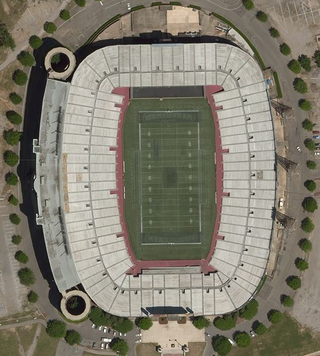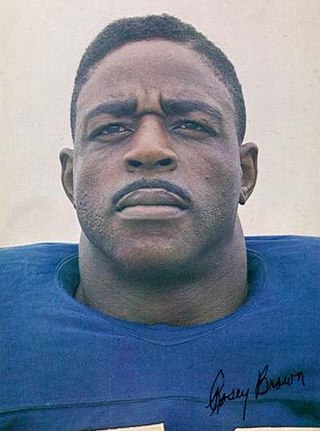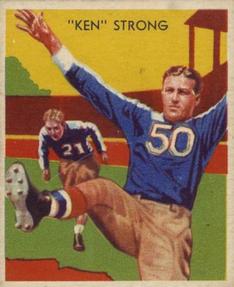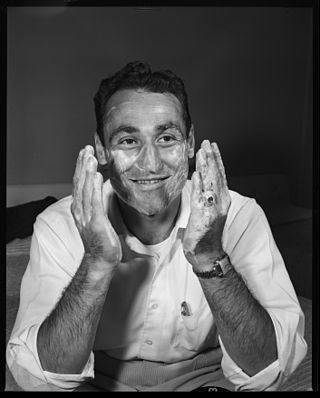Related Research Articles

The Polo Grounds was the name of three stadiums in Upper Manhattan, New York City, used mainly for professional baseball and American football from 1880 to 1963. The original Polo Grounds, opened in 1876 and demolished in 1889, was built for the sport of polo. Bound on the south and north by 110th and 112th streets and on the east and west by Fifth and Sixth (Lenox) avenues, just north of Central Park, it was converted to a baseball stadium when leased by the New York Metropolitans in 1880.

Legion Field is an outdoor stadium in the southeastern United States in Birmingham, Alabama, primarily designed to be used as a venue for American football, but occasionally used for other large outdoor events. Opened in 1927, it is named in honor of the American Legion, a U.S. organization of military veterans.

The Continental Football League (COFL) was a professional American football minor league that operated in North America from 1965 through 1969. It was established following the collapse of the original United Football League, and hoped to become the major force in professional football outside the National Football League (NFL) and the American Football League (AFL). It owed its name, at least in part, to the Continental League, a proposed third Major League Baseball organization that influenced MLB significantly, although they never played a game.

Roosevelt "Rosey" Brown Jr. was an American professional football offensive tackle who played in the National Football League (NFL) for the New York Giants from 1953 to 1965. He played college football for the Morgan State Bears and was selected by the Giants in the 27th round of the 1953 NFL draft.
Joseph Wiley Gilliam Jr. was an American professional football player, a quarterback with the Pittsburgh Steelers of the National Football League (NFL) for four seasons. Primarily a backup, he started the first six games of the 1974 season.

John Oscar Dickshot, nicknamed "Ugly" Johnny Dickshot, was an American professional baseball left fielder. He played in Major League Baseball for the Pittsburgh Pirates, the New York Giants, and the Chicago White Sox. His professional career, including the seasons he spent in Minor League Baseball, ran from 1930 to 1947. He received the nickname "Ugly" because he proclaimed himself to be "the ugliest man in baseball" during his career.
Gary Phillip Reasons is an American former professional football player who was a linebacker in the National Football League (NFL). He played college football for the Northwestern State Demons from 1980 to 1983 and was the first player chosen as a first-team Division I-AA All-America team in three consecutive years. He also played professional football in the NFL for the New York Giants (1984–1991) and Cincinnati Bengals (1992). He played on the Giants teams that won Super Bowl XXI and Super Bowl XXV. Reasons later worked as a college football television analyst and sideline reporter for ABC/ESPN and Fox Sports Southwest. He has been inducted into the College Football Hall of Fame and the Louisiana Sports Hall of Fame.
Orange High School is a three-year comprehensive public high school that serves students in tenth through twelfth grades from Orange in Essex County, in the U.S. state of New Jersey, operating as part of the Orange Board of Education. The school has been accredited by the Middle States Association of Colleges and Schools Commission on Elementary and Secondary Schools since 1928.
Douglas Allan Kotar was an American football running back for the New York Giants of the National Football League (NFL).
Michael James Fox is an American former professional football player who was a defensive lineman in the National Football League (NFL). He was selected by the New York Giants in the second round of the 1990 NFL draft. He played college football for the West Virginia Mountaineers.

Elmer Kenneth Strong was an American professional football player who was a halfback and fullback. He also played minor league baseball. Considered one of the greatest all-around players in the early decades of the game, he was inducted into the College Football Hall of Fame in 1957 and the Pro Football Hall of Fame in 1967 and was named to the NFL 1930s All-Decade Team.
The Vulcan Bowl was a college football bowl game played at Rickwood Field in Birmingham, Alabama. The game was played on New Year's Day between 1941 and 1949 and again in 1952, between historically black colleges and universities (HBCUs). The game was one of the longer-lasting bowls for HBCUs established in the 1940s. The first game in the series was called the Steel Bowl, and the bowl game served as an early era black college football national championship game by matching the Southern Intercollegiate Athletic Conference champion against the best team from the other HBCU conferences. The final contest was also called the Steel Bowl and was played at Legion Field.

Arnold Anthony Galiffa was an American professional football player who was a quarterback in the National Football League (NFL) and Canadian Football League (CFL). He played college football for the Army Black Knights, then played professionally in both the NFL and CFL. He was inducted to the College Football Hall of Fame in 1983.
The 1975 World Football League season was the second and last season of the World Football League. The 1975 season was to be an 18-game season over a twenty-week schedule.

The 1972 Rutgers Scarlet Knights football team represented Rutgers University in the 1972 NCAA University Division football season. In their 13th and final season under head coach John F. Bateman, the Scarlet Knights compiled a 7–4 record. The team outscored its opponents 290 to 171. The team's statistical leaders included Leo Gasienica with 1,409 passing yards, J. J. Jennings with 1,262 rushing yards, and Tom Sweeney with 369 receiving yards.

The 1971 Rutgers Scarlet Knights football team represented Rutgers University in the 1971 NCAA University Division football season. In their 12th season under head coach John F. Bateman, the Scarlet Knights compiled a 4–7 record and were outscored by their opponents 243 to 193. The team's statistical leaders included Leo Gasienica with 1,148 passing yards, Larry Robertson with 405 rushing yards, and Bob Carney with 351 receiving yards.
Robert Edward Gunderman was an American football end who played college football for University of Virginia and professional football in the National Football League (NFL) for the Pittsburgh Steelers in 1957. He appeared in four NFL games.
James Franklin Teal was an American football linebacker who played college football for Purdue (1969–1971) and professional football in the National Football League (NFL) for the Detroit Lions (1973), in the World Football League (WFL) for the Birmingham Americans/Birmingham Vulcans (1974-1975), and in the Canadian Football League (CFL) for the Ottawa Rough Riders (1977).
Cephus Weatherspoon is a former American football wide receiver who played professionally for the New Orleans Saints of the National Football League (NFL) and the Birmingham Vulcans of the World Football League (WFL).
References
- ↑ Cargile, John (August 21, 1975). "Vulcans fuel up with Gasienica". Birmingham Post-Herald . p. 12 – via Newspapers.com.

- ↑ O'Brien, Ken (September 13, 1972). "Knowing He's QB, Gasienica Has New Outlook This Year". The Central New Jersey Home News . p. 32 – via Newspapers.com.

- ↑ "Gasienica cut by Giants". The Central New Jersey Home News . August 1, 1973. p. 36 – via Newspapers.com.

- ↑ "Steelers waive Leo Gasienica". The Record . September 11, 1974. p. 26 – via Newspapers.com.
